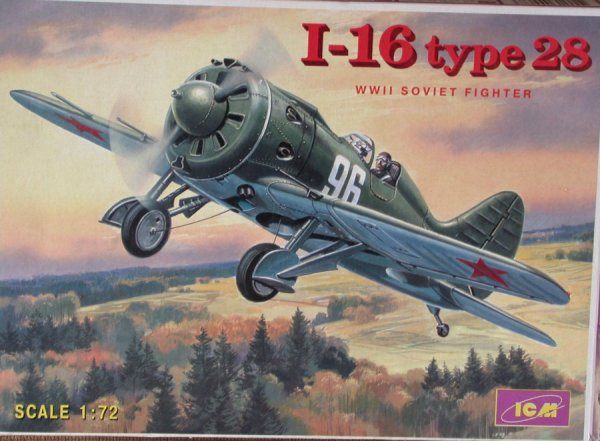
ICM 1/72 I-16 type 28 'Rata'
|
KIT # |
|
|
PRICE: |
$12 AUD |
|
DECALS: |
Two Aircraft |
|
REVIEWER: |
Mark Fordham |
|
NOTES: |
Aircraft depicted as one of the Alpine fighter collection aircraft. |

|
HISTORY |
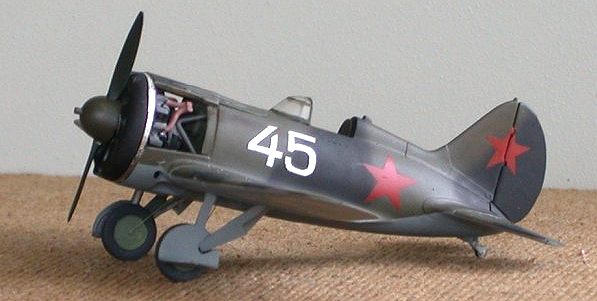
The I 16 first appeared on the drawing boards in 1932 and was popularly known in Russia as the 'Ishak' (Little Donkey). During its Spanish Civil War service the Republicans dubbed it 'Mosca' (Fly) while their opponents the Nationalists referred to it as the 'Rata' (Rat).
The first prototype was flown in December of 1933 with mass production in full swing by 1935. The production models proved to be the most advanced fighter design of the time. This was the first high-performance monoplane fighter in the world with a retractable undercarriage, and despite many shortcomings the aircraft was a potent weapon in the hands of expert pilots.
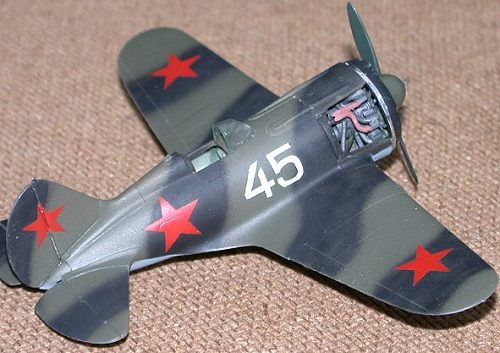 The Alpine
fighter Collection of New Zealand have restored six Polikarpov I-16 as type 24
fighters as this type was considered to the best of the production I-16's and
the original 1000 hp powerplants were still available. The Alpine Fighter
Collection are the only flying I-16 in the world.
The Alpine
fighter Collection of New Zealand have restored six Polikarpov I-16 as type 24
fighters as this type was considered to the best of the production I-16's and
the original 1000 hp powerplants were still available. The Alpine Fighter
Collection are the only flying I-16 in the world.
The Soviet authorities appointed a commission to oversee and control the restoration programme and each aircraft was test flown in Siberia by their test flight department prior to export to New Zealand.
In 1998 the Alpine fighter Collection hosted it's Bi-annual Warbirds over Wanaka and the theme that year was not surprisingly called Red Stars Rising, were along with two I-153 six I-16 'Ishak's' made their debut in New Zealand. The Sound of 4 I-16's ands two I-153 in the air together was a sound not heard for over fifty years.
Thanks to the hard work of Sir Tim Wallis's and the Alpine Fighter Collection these Small noisy beasts are once again terrorising the local wildlife.
ZK-JIP '45' (c/n 2421645) Built in 1939, the aircraft is believed to have served with the Leningrad Front Fighter Squadron (part of the Baltic Fleet Air Forces). The aircraft was found near Osinovets (near Leningrad) in 1991. It was registered in New Zealand on October 9th, 1997. Registration passed to American Airpower Heritage Museum, still at Wanaka on October 25, 2001. (As Quoted from kiwiaircraftimages.com)
|
THE KIT |
The ICM I-16 comes in a rather flimsy end opening box that had been crushed quite badly in transit, the innards consisted of one sprue of softish white plastic containing the diminutive I-16, a separately packaged canopy, instruction sheet in typical ICM two color printing and a small decal sheet with makings for two aircraft.
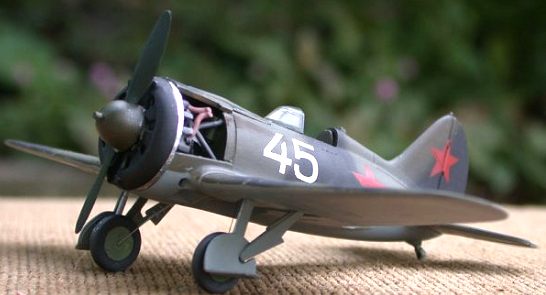 Looking at the break down of the
parts on the sprue and reading another online build of this kit forewarned me of
the problems that lay ahead with this one.
Looking at the break down of the
parts on the sprue and reading another online build of this kit forewarned me of
the problems that lay ahead with this one.
For some strange reason ICM have decided to follow a unconventional route for the moulding of the wings and engine cowlings that was to come back and bite me later on in the construction.
ICM's little 'Ishak' shapes up well against the Hasegawa offering in the same scale , ICM give you more cockpit detail and a comprehensive engine detail to boot and equal Hasegawa's for wheel-well detail and crispness of moulding, panel lines are subtlety done with no flash or noticeable sink marks and the ejector pin marks are mostly in hidden places.
Painting details for two generic Russian machines are printed on the back of the box and are rather insipidly printed.
|
CONSTRUCTION |
Construction begins with the tiny cockpit consisting of a floor, seat instrument panel and controls, more than adequate for this scale and careful dry-brushing will bring out the finally moulded detail.
Fuselage construction was straight forward with little in the way of joint lines or flash to clean up, mind you the I16 has got to be one of the smallest aircraft in 1/72nd scale to work on, as shown by the size comparison to a NZ 5 cent piece.
The ICM I-16 is unusual in the respect that a good 1/3rd of the wing as far as the wing guns is moulded with the fuselage and it is a simple matter to glue the one piece outer panels in place, joint lines are easy to clean up/hide as they correspond to real panel lines.
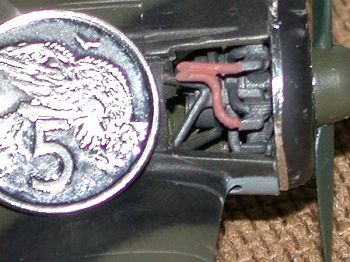 Moving on the
engine detail bought up a few problems with the fit of the nose area, ICM have
these two little wing root inserts that have been moulded in such a way that
makes them almost impossible to install without spending a fair amount of time
lining them up and hiding the gaps, this is probably the most fiddly part about
this kit and would provide some major headaches to the more novice builder,
after much swearing and cursing I finally got them in place.
Moving on the
engine detail bought up a few problems with the fit of the nose area, ICM have
these two little wing root inserts that have been moulded in such a way that
makes them almost impossible to install without spending a fair amount of time
lining them up and hiding the gaps, this is probably the most fiddly part about
this kit and would provide some major headaches to the more novice builder,
after much swearing and cursing I finally got them in place.
The very nicely detailed M-62 was carefully painted and dry brushed to bring out all the detail, The I16 comes with a fair amount of engine bay detail including a full firewall, bottles, engine bearers, and the complex exhaust system, all of which is crammed into the most unbelievably small space!
I had to trim a smidgen off the bearers to get the M-62 to sit square but thatís because I didnít check the alignment of the engine frame at assembly time and the bottom had skewed sideways a touch.
The I16 has quite a complex undercarriage system that has been well thought out by ICM making installing the doors reasonably painless, do remember to bend the bottom half of the gear door up though before gluing them onto the undercarriage legs (easier to do that way)
At this stage most of the construction was complete and it was I thought a quick job to tack on the engine side panels and roar (ummmm clatter) off to the paint room, but alas it was not to be so easy, in my efforts to get the wing root fillets to sit properly I must have not lined them up correctly as the side panels did not fit at all well being slightly too wide and slightly too short, I will however stress that this is more than likely sloppy construction rather than a problem with the kit but it meant that I couldnít use the side panels. Ahh well, paint them anyway and leave them off, It was a shame to cover up that lovely little engine anyway.
|
CAMO & MARKINGS |
 The two
schemes that were supplied by ICM just didnít do anything for me at all with
both of them being Russian green over tractor blue (yuk) so after mush
fossicking around I decided to do one of the Alpine Fighter Trust I-16's rather
than "real" WWII scheme. On page 67 of "The Best of Warbirds Over Wanaka" I
found a nice photo of I-16 "45" taxing along the grass, looking splendid in it's
olive drab / black over grey camo scheme. Yup thatís the one for me.
The two
schemes that were supplied by ICM just didnít do anything for me at all with
both of them being Russian green over tractor blue (yuk) so after mush
fossicking around I decided to do one of the Alpine Fighter Trust I-16's rather
than "real" WWII scheme. On page 67 of "The Best of Warbirds Over Wanaka" I
found a nice photo of I-16 "45" taxing along the grass, looking splendid in it's
olive drab / black over grey camo scheme. Yup thatís the one for me.
So breaking out the Tamiya light sea grey a couple of coats were sprayed over the underside of the poly, once dry and masked off the upper surfaces were first sprayed Tamiya olive drab and then Tamiya black green with 20 % more black added was free hand sprayed over the olive drab using a Paasche VSR90 at 25 psi.
Once the paint had hardened for a day or two it was time for the markings, in this case I decided not to use the kit decals as I was inspired by Rick Brownlee's I-16 Review on how to paint your markings on.
Thanks to Rick I now use this method for almost all my national marking now except for British roundels. My method is as follows for Russian aircraft, find and download a wingding star font from the internet, scale star to 36 point font size for Wing markings and 24 point for tail markings, print solid stars onto circa 1970's kitchen spice labels with it's groovy orange and dark brown trim (easy to peel off and the paper has a very high fibre density.) using a laser printer. Then carefully cut out the star using a new #11 blade and steel rule, DONíT throw out the center star, put it to one side.
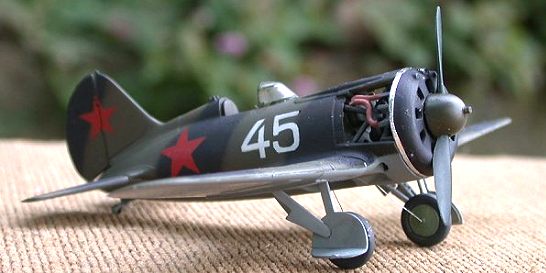 One I had completed cutting
out all the stars I used the inner part of the star as a guide to help correctly
line up the positions of the stars, once happy with the positioning burnished
down the outside star mask and picked out the center star. The stars were then
sprayed using Tamiya red and left to dry before removing the masks carefully,
and I say carefully as I have been able to get four or five sprays out of one
set of masks before the labels lose their stick.
One I had completed cutting
out all the stars I used the inner part of the star as a guide to help correctly
line up the positions of the stars, once happy with the positioning burnished
down the outside star mask and picked out the center star. The stars were then
sprayed using Tamiya red and left to dry before removing the masks carefully,
and I say carefully as I have been able to get four or five sprays out of one
set of masks before the labels lose their stick.
The white "45" were done the same way after wading my way through something like 2000 fonts until I found one that matched the same sort of style as the Alpine I-16.
Finally assembly consisted of replacing the ICM canopy with a home vacuformed copy made from a mould of the Hasegawa canopy as it is more accurate than ICM's one and adding thin wire to the undercarriage.
|
CONCLUSIONS |
Well when it comes to the little I-16 I'm kind of biased, as in it is one of a handful of aircraft that I would be happy to build in any scale. Even that dreaded 1/4 scale that everyone's so hot on these days.
ICM's Polokarpov stacks up well against the Hasegawa offering apart from the fiddly wing root inserts, with care a very nice little " Ishak" can be added to your collection. Go ahead grab one today and while your at it grab a copy of "Warbirds over Wanaka " it's worth it just for the photos of five Yes five I-16's flying over Lake Wanaka.
July 2002
|
REFERENCES |
The Best of Warbirds over Wanaka by Brodie/Makanna ISBN 0-7900-0837-8
http://www.kiwiaircraftimages.com/i16.html
Copyright ModelingMadness.com. All rights reserved. No reproduction in part or in whole without express permission from the editor.
If you would like your product reviewed fairly and quickly, please contact the editor or see other details in the Note to Contributors.